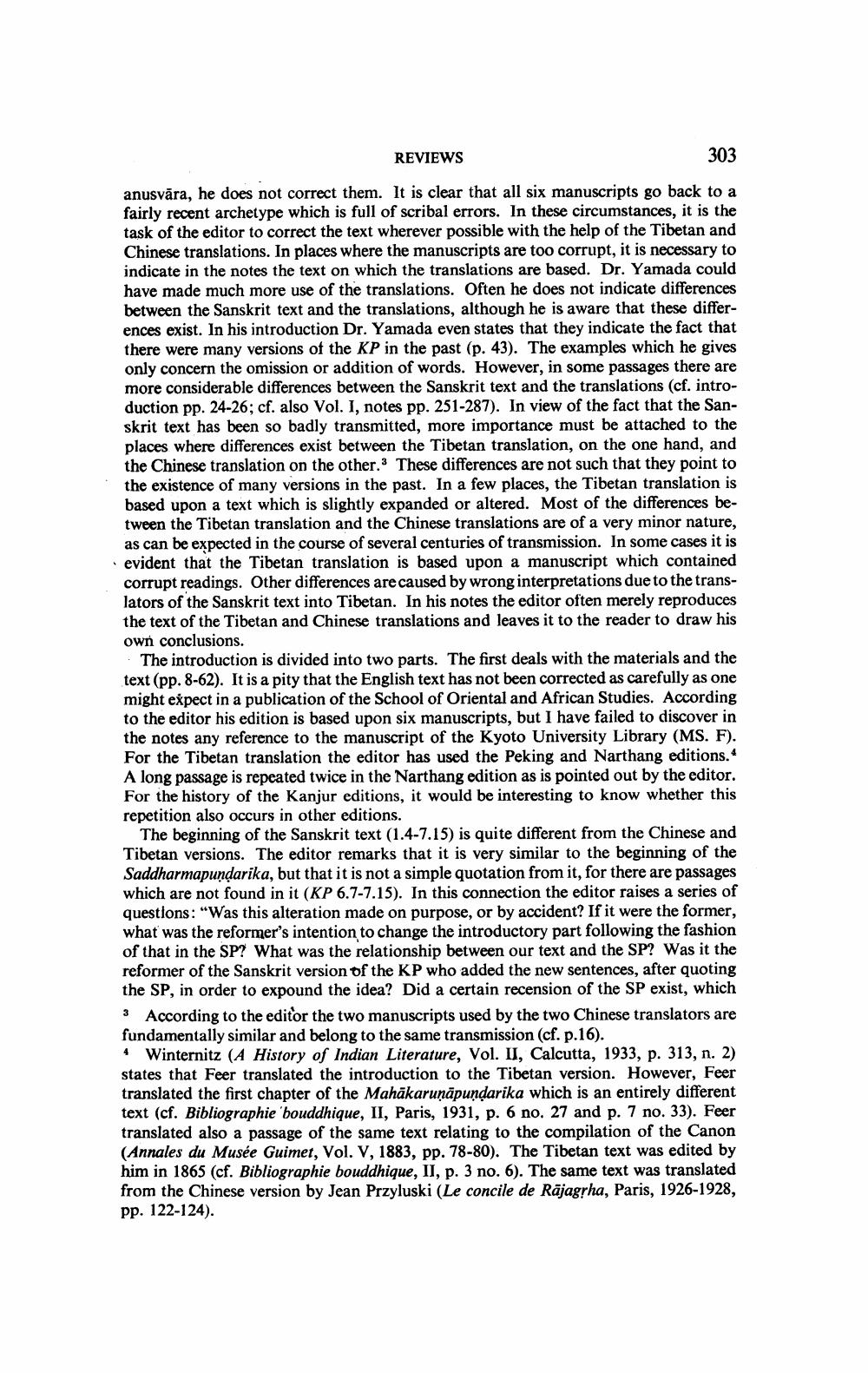Book Title: Reviews Of Different Books Author(s): Publisher: View full book textPage 7
________________ REVIEWS 303 anusvara, he does not correct them. It is clear that all six manuscripts go back to a fairly recent archetype which is full of scribal errors. In these circumstances, it is the task of the editor to correct the text wherever possible with the help of the Tibetan and Chinese translations. In places where the manuscripts are too corrupt, it is necessary to indicate in the notes the text on which the translations are based. Dr. Yamada could have made much more use of the translations. Often he does not indicate differences between the Sanskrit text and the translations, although he is aware that these differences exist. In his introduction Dr. Yamada even states that they indicate the fact that there were many versions of the KP in the past (p. 43). The examples which he gives only concern the omission or addition of words. However, in some passages there are more considerable differences between the Sanskrit text and the translations (cf. introduction pp. 24-26; cf. also Vol. I, notes pp. 251-287). In view of the fact that the Sanskrit text has been so badly transmitted, more importance must be attached to the places where differences exist between the Tibetan translation, on the one hand, and the Chinese translation on the other. These differences are not such that they point to the existence of many versions in the past. In a few places, the Tibetan translation is based upon a text which is slightly expanded or altered. Most of the differences between the Tibetan translation and the Chinese translations are of a very minor nature, as can be expected in the course of several centuries of transmission. In some cases it is evident that the Tibetan translation is based upon a manuscript which contained corrupt readings. Other differences are caused by wrong interpretations due to the translators of the Sanskrit text into Tibetan. In his notes the editor often merely reproduces the text of the Tibetan and Chinese translations and leaves it to the reader to draw his own conclusions. * The introduction is divided into two parts. The first deals with the materials and the text (pp. 8-62). It is a pity that the English text has not been corrected as carefully as one might expect in a publication of the School of Oriental and African Studies. According to the editor his edition is based upon six manuscripts, but I have failed to discover in the notes any reference to the manuscript of the Kyoto University Library (MS. F). For the Tibetan translation the editor has used the Peking and Narthang editions. A long passage is repeated twice in the Narthang edition as is pointed out by the editor. For the history of the Kanjur editions, it would be interesting to know whether this repetition also occurs in other editions. The beginning of the Sanskrit text (1.4-7.15) is quite different from the Chinese and Tibetan versions. The editor remarks that it is very similar to the beginning of the Saddharmapundarika, but that it is not a simple quotation from it, for there are passages which are not found in it (KP 6.7-7.15). In this connection the editor raises a series of questions: "Was this alteration made on purpose, or by accident? If it were the former, what was the reformer's intention to change the introductory part following the fashion of that in the SP? What was the relationship between our text and the SP? Was it the reformer of the Sanskrit version of the KP who added the new sentences, after quoting the SP, in order to expound the idea? Did a certain recension of the SP exist, which 3 According to the editor the two manuscripts used by the two Chinese translators are fundamentally similar and belong to the same transmission (cf. p.16). 4 Winternitz (A History of Indian Literature, Vol. II, Calcutta, 1933, p. 313, n. 2) states that Feer translated the introduction to the Tibetan version. However, Feer translated the first chapter of the Mahakarunapundarika which is an entirely different text (cf. Bibliographie' bouddhique, II, Paris, 1931, p. 6 no. 27 and p. 7 no. 33). Feer translated also a passage of the same text relating to the compilation of the Canon (Annales du Musee Guimet, Vol. V, 1883, pp. 78-80). The Tibetan text was edited by him in 1865 (cf. Bibliographie bouddhique, II, p. 3 no. 6). The same text was translated from the Chinese version by Jean Przyluski (Le concile de Rajagrha, Paris, 1926-1928, pp. 122-124).Page Navigation
1 ... 5 6 7 8 9 10 11 12 13 14 15 16 17 18 19 20 21 22 23
